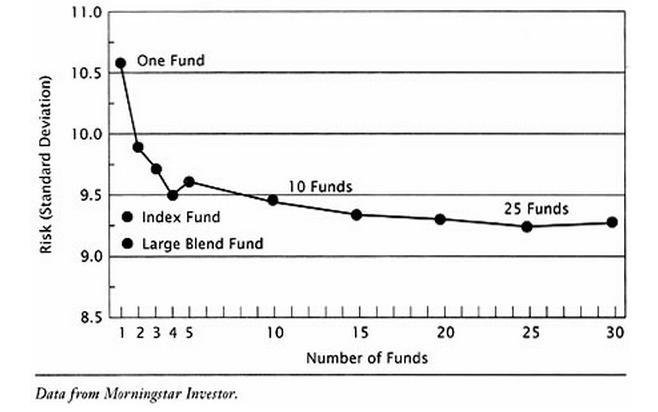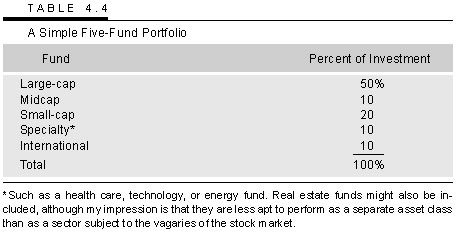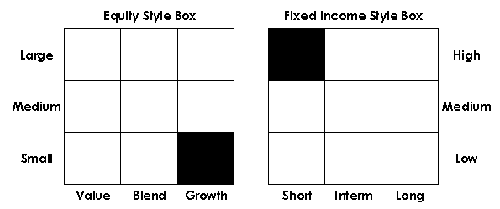In our earlier post, Many Mutual Funds: Diversification or Diworsification ,we had talked about one of the easiest ways to diversify is through ownership of mutual funds rather than stocks. But having a portfolio with more mutual funds does not mean better returns, as many mutual funds often invest in the same stocks or sectors. When an investor over-diversifies his investment portfolio by investing in too many funds it can cause Diworsification. We had also seen how to find overlap among different mutual funds. Question is how many mutual funds should one own which does provides enough exposure balancing risk and volatility?
Table of Contents
Morningstar Research on American Funds
Morningstar, a Chicago-based independent investment research company constructed hypothetical portfolios ranging from 1 to 30 American mutual funds in all possible combinations. It then calculated the five-year standard deviation for each of those portfolios to estimate the risk and volatility. Standard deviation is probably the most common measure of a mutual fund’s risk. Standard deviation quantifies how much the returns of a fund vary around their mean, or average. In this way, standard deviation provides a precise measure of how varied a fund’s returns have been over a particular time frame. The higher the standard deviation of a fund, the more varied or volatile its returns have been. Sectoral funds will typically have a much higher standard deviation and large-cap equity products a lower standard deviation. Mutual Fund Research: What You Should Know About Standard Deviation talks about Standard Deviation in detail. Coming back to the research
Single fund portfolios had the highest standard deviation and, hence, greater risk. A few funds delivered either the biggest gains or heaviest losses. Adding a fund to the portfolio reduced standard deviation considerably. Returns were lower, but downside was lower too. However, after four funds, the effect of adding another fund diminished. Risk remains fairly constant, all the way out to 30 funds Figure shows the extent to which the standard deviation of the various fund portfolios declined as more funds were added.
MorningStar Research on Indian Funds
Quoting from MoneyLife:Mutual fund investing: How many schemes should you have? (Aug 2011)
Analysing the top 10 holdings of 215 equity diversified mutual fund schemes, we find that 316 stocks are the most preferred for the schemes that have disclosed the names of their invested stocks. Ten or more schemes had top 10 of their picks in just 47 companies. A total of 10 firms are present in 50 and more schemes. These schemes invest nearly half their assets in the top 10 holdings. Most schemes have similar portfolios with overlapping firms.
JagoInvestor Data
In the book Jagoinvestor’s:Change your relationship with money(our review), Jagoinvestor has shown a chart which tells you how much exposure a person can get by investing in 2,5 and 10 mutual funds. (pg 134 of the book)
Quoting from the book:
If you look at the chart above you will see that a person who has invested in just 2 mutual funds is already exposed to 74 different stocks, out of which 49 stocks are of big companies (large cap) comprising 85% of the investment and remaining 25 companies are mid size companies, which account for rest of his investment. Now that’s a decent enough exposure already. But still some more funds can be added to the portfolio, if one really thinks he should add more.
By adding 3 more funds(a total of 5) the exposure goes to 111 stocks, out of which 59 are lae companies comprising 81% of the money invested and the remaining goe sinto mid-sized companies. Now beyond this point, it does not make much sense to include more funds of the same category because it only adds to the clutter and does not add value.
I personally feel that one should restrict oneself to just 2-3 mutual funds. This strategy provides decent exposure and makes a portfolio extremely easy to manage.
Ideal number of funds
John C. Bogle in his book, Common Sense on Mutual Funds-New Imperatives for the Intelligent Investor , pages 101-102,suggests simple five-fund portfolio would suit the needs of investors. The book features in 15 Business Books That Could Actually Help Make You Rich list of ConsumerAffairs.(I haven’t read the book so can’t say much except maybe that’s why I am not rich )
Personal finance blogger, JagoInvestor:How many Mutual Funds you should have ? ( Feb 2010) suggests following funds.
- 2-3 Equity diversified Mutual Fund (Tax + Non-Tax saving)
- 1-2 Debt Fund
- 1-2 ETF’s or Index Funds
Note that 2-3 Equity Diversified Mutual funds will cover almost all the big companies in your portfolio. Some ETF or index fund will give index level exposure and make sure you invest in top companies. Debt funds will add exposure to Debt part and no-correlation with Equity.
Personal finance blogger, TheWealthWisher:How many mutual funds should you invest in ? (Oct 2010) suggests:
This is how the 7-8 mutual fund can be composed.
- Pick 2 large cap equity diversified mutual funds.
- Pick 2 mid cap equity diversified mutual funds.
- Pick 2 sectoral or thematic mutual funds.
- Pick 2 debt mutual funds.
Building Mutual Funds Portfolio
There is just no one-size-fits-all answer. There is no one “correct” way to build a mutual fund portfolio. Putting together a group of mutual funds is a matter of personal preference, goals and situation. Having thousands of mutual funds adds to the confusion. Various approach are suggested such as Asset Allocation Approach, Style Box Approach or Core-Satellite Approach.
AssetAllocation Approach: Build mutual fund portfolio having fixed or variable mix of the main asset classes – stocks, bonds. Choose different equity funds and debt fund or choose balanced funds which invest in both equity(more than 65%) and debt.
Style Box Approach: Style box is designed to visually represent the investment characteristics of fixed-income (bond), domestic equity (stock) mutual funds.There are slightly different style boxes used for equity and fixed-income funds as shown in figure:
- For equity funds, the horizontal axis of the style box is divided into three investment style categories: value, blend (a value/growth mix) and growth. The vertical axis is divided into three company-size (based on market-capitalization) indicators: large, medium and small.
- For bonds and bond funds, the horizontal axis is divided into three maturity categories: short-term, intermediate-term, and long-term. The vertical axis is divided into three credit-quality categories: high, medium and low .
Investors can use a style box to put together mutual fund portfolio. For example, an investor looking for a relatively safe stock fund would seek out one categorized as a large-cap value fund. If that same investor is willing to accept more risk for the opportunity of a greater return, he/she might select a fund in the small-cap growth category. A style box is a valuable tool for investors to use to determine the asset allocation and risk-return structures of their portfolios and/or how a security fits into their investing criteria.
Core and Satellite approach:A core portfolio typically comprises diversified assets of high quality, is 80-90 % of the total investible money, to deliver over the long term. Satellite portfolio is a small portfolio, say 10-20 % of the total investible money which is used to tap the short-term opportunities in the market. This kind of approach gives stability and growth. EconomicTimes:Your guide to core and satellite investing (Jan 2011) discusses the concept in detail. Valuereseachonline:The Core & Satellite Approach answers user query on funds to invest in. Quoting from it:
You can have 2-3 funds as core holdings comprising large-cap and large- and mid-cap funds, with the satellite component with sector funds and multi-cap funds to achieve long-term wealth appreciation. This way, the investments have the ability to absorb shocks as well as have the potential to earn higher returns over various market cycles.
Steps to limit number of funds
No matter what approach or mix of approach you follow Please try to limit the number of funds in your portfolio while still feeling comfortable with your holdings. Don’t simply chase funds that have become star performers. Before adding a fund consider following:
- It begins by considering your objectives. If capital preservation is your objective, a small-cap fund may not be needed either. If income is your primary goal, that international fund may not be necessary.
- Once you’ve determined the mix of funds that you wish to consider, compare their underlying holdings. If two or more funds have significant overlap in holdings, some of those funds can be eliminated. There’s simply no point in having multiple funds that hold the same underlying stocks.
- Next, look at the expense ratios. When two funds have similar holdings, go with the less expensive choice and eliminate the other fund. Every penny saved on fees is one more penny working for you. If you are working with an existing portfolio rather than building one from scratch, eliminate funds that have balances that are too small to make an impact on overall portfolio performance. If you’ve got three large-cap funds, move the money to a single fund. The amount spent on management-related expenses is likely to decrease and your level of diversification will remain the same.
John C. Bogle , author of the book, Common Sense on Mutual Funds-New Imperatives for the Intelligent Investor , argues for an approach to investing defined by simplicity and common sense. Below are his eight basic rules for investors of Mutual funds :
- Select low-cost index funds
- Consider carefully the added costs of advice
- Do not overrate past fund performance
- Use past performance to determine consistency and risk
- Beware of stars (as in, star mutual fund managers)
- Beware of asset size
- Don’t own too many funds
- Buy your fund portfolio – and hold it
Related Articles:
- Many Mutual Funds: Diversification or Diworsification
- What is Investing
- Finding Info on NFOs of FMP,MFs,FD and Saving Interest Rates
- Book Review-JagoInvestor:Change your relationship with money
Although there are hundreds of mutual fund providers offering thousands of funds, there’s no magical “right” number of mutual funds. Nearly everyone agrees that there is no need for dozens of holdings. As Warren Buffett says, “Wide diversification is only required when investors do not understand what they are doing“. In other words, if you diversify too much, you might not lose much, but you won’t gain much either. How do you choose your mutual funds? How many mutual funds do you own?







